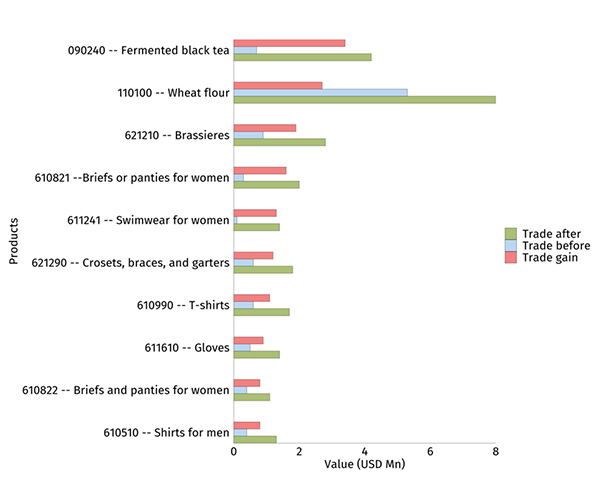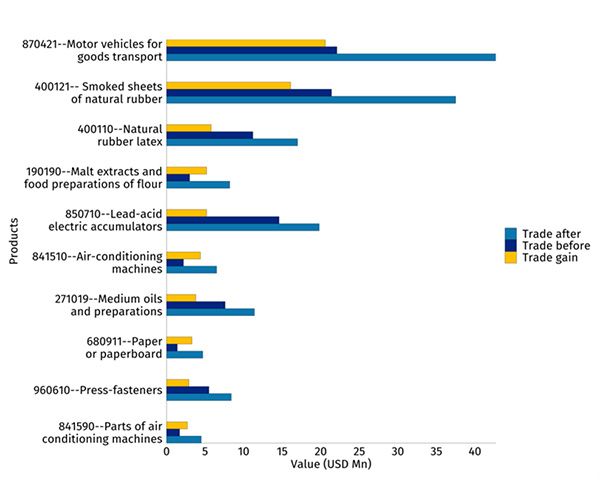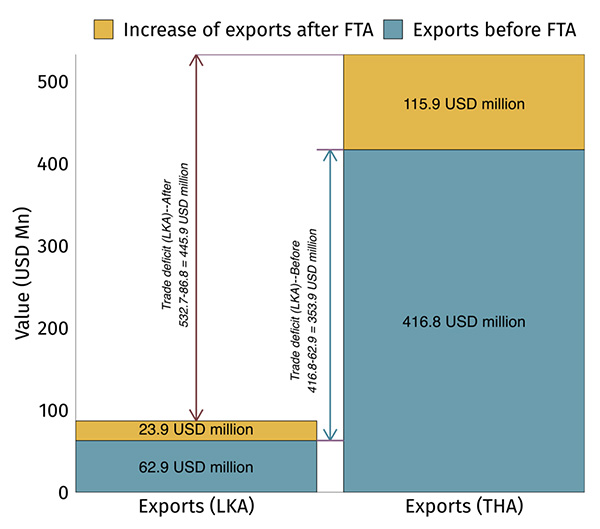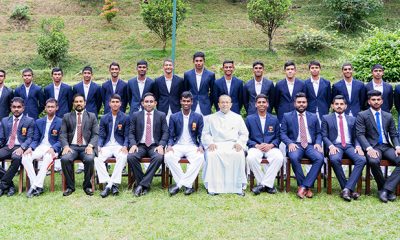Business
Overcoming Obstacles: The economic case for a Sri Lanka-Thailand FTA

By Asanka Wijesinghe and Nilupulee Rathnayake
In 2019, only 6 % of tea imported by Thailand was from Sri Lanka. This low percentage can be attributed to the difference in preferences and Thailand’s high tariffs of 90 % on imported tea, which act as barriers to Sri Lanka’s tea exports. Additionally, Thailand imposes up to 30 % tariffs on nearly 120 product lines of wearing apparel.
These high tariffs for products with a comparative advantage are not exclusive to Sri Lanka. Thailand also faces higher tariffs for vehicles, rubber, and light-electronics exports which Thailand exports competitively. This tariff structure hampers the bilateral trade of products with a higher comparative advantage for both countries.
Despite these challenges, Sri Lanka and Thailand have expedited the process of signing a free trade agreement (FTA) to boost bilateral trade by threefold to USD 1.5 billion. This article discusses the trade effect of an FTA and a way forward to maximise the gains from an FTA.
Existing Trade is Skewed
towards Thailand
 In the pre-pandemic period, Sri Lanka-Thailand bilateral trade was nearly USD 500 million. The three-year-2017, 2018 and 2019- average exports from Sri Lanka to Thailand were USD 62.9 million, while the exports from Thailand to Sri Lanka were USD 416.8 million. In 2019, Thailand was the 9th largest import source for Sri Lanka, but Sri Lanka is only the 73rd largest import source for Thailand. The mismatch resulted in a bilateral trade deficit of USD 353.9 million.
In the pre-pandemic period, Sri Lanka-Thailand bilateral trade was nearly USD 500 million. The three-year-2017, 2018 and 2019- average exports from Sri Lanka to Thailand were USD 62.9 million, while the exports from Thailand to Sri Lanka were USD 416.8 million. In 2019, Thailand was the 9th largest import source for Sri Lanka, but Sri Lanka is only the 73rd largest import source for Thailand. The mismatch resulted in a bilateral trade deficit of USD 353.9 million.
The existing exports from Sri Lanka to Thailand do not represent Sri Lanka’s typical export basket. The contribution of traditional exports like ready-made garments, tea, rubber, and coconuts is relatively low, and gems, electrical equipment, wheat flour, and activated carbon contribute to a greater extent. Technically specified natural rubber and latex are the top exports from Thailand which are essential raw materials in the value-added rubber industry of Sri Lanka.
Effect of Lowering Tariffs on Bilateral Trade to Zero
 As estimated from partial equilibrium analysis, Sri Lanka will realise a 38 % increase in exports to Thailand if tariffs are reduced to zero (Figure 2). The wearing apparel sector would be the biggest beneficiary, with exports projected to increase by 251 % from USD 6.4 million to USD 22.5 million. Figure 3A provides the top ten exports by Sri Lanka benefitting from a tariff removal by Thailand. The export effect for Thailand will be 27.8 % and Thailand’s rubber and plastic products will be increased by 71.9 % or USD 35.4 million. Products such as smoked sheets of rubber and natural latexwould benefit the most from tariff elimination, as shown in Figure 3B.
As estimated from partial equilibrium analysis, Sri Lanka will realise a 38 % increase in exports to Thailand if tariffs are reduced to zero (Figure 2). The wearing apparel sector would be the biggest beneficiary, with exports projected to increase by 251 % from USD 6.4 million to USD 22.5 million. Figure 3A provides the top ten exports by Sri Lanka benefitting from a tariff removal by Thailand. The export effect for Thailand will be 27.8 % and Thailand’s rubber and plastic products will be increased by 71.9 % or USD 35.4 million. Products such as smoked sheets of rubber and natural latexwould benefit the most from tariff elimination, as shown in Figure 3B.
Assuming an immediate phasing-out of the existing tariffs, an FTA would increase bilateral trade to USD 619.6 million by 29.1 %. This increase falls short of the ambitious goal of a threefold increase in bilateral trade, at least in the short run.
However, partial equilibrium analysis does not estimate the trade gains from new product innovations due to FDI movements. The estimates also do not account for trade effects through input-output linkages and magnification of tariff effects along the value chains. However, tariff phasing out takes time, and FTA coverages are less than 100 %.
Notes: Simulations were done for Global Trade Analysis Project (GTAP) 47-sectors using sector-specific Armington Elasticities. The base years were 2021, and 2017 for Thailand and Sri Lanka, respectively.
Maximising Trade Gains
through Offensive Lists
 An offensive list contains products for which a country has a comparative advantage, capacity for expansion, and a favourable tariff from the importing country. There are 154 such products for Sri Lanka. Notably, 81 % of the USD 27.6 million export gain from an FTA comes from these 154 product lines. Similarly, 69 % of Thailand’s export gains to Sri Lanka in an FTA comes from 147 products identified for the offensive list.
An offensive list contains products for which a country has a comparative advantage, capacity for expansion, and a favourable tariff from the importing country. There are 154 such products for Sri Lanka. Notably, 81 % of the USD 27.6 million export gain from an FTA comes from these 154 product lines. Similarly, 69 % of Thailand’s export gains to Sri Lanka in an FTA comes from 147 products identified for the offensive list.
Once ordered by the estimated export gains, nine out of the top ten products of Sri Lanka’s offensive list are from the wearing apparel sector. For Thailand, vital offensive products are rubber, electric equipment like air-conditioners and refrigerators, and motor vehicles for goods transportation.
Challenges and the Way Forward:
 Applying tariff cuts for all the products in the offensive lists is a challenge. Thailand’s high tariffs for tea and ready-made exports indicate its protectionist intent. Likewise, Sri Lanka might prefer to keep tariffs on rubber products. Significant political manoeuvring and delicate negotiations will be required to bring the coverage of the FTA to a satisfactory level. Secondly, an FTA will widen Sri Lanka’s trade deficit with Thailand by 26 % (Figure 4). Although a trade deficit is not necessarily detrimental, it does present a short-term challenge due to increased dollar outflow.
Applying tariff cuts for all the products in the offensive lists is a challenge. Thailand’s high tariffs for tea and ready-made exports indicate its protectionist intent. Likewise, Sri Lanka might prefer to keep tariffs on rubber products. Significant political manoeuvring and delicate negotiations will be required to bring the coverage of the FTA to a satisfactory level. Secondly, an FTA will widen Sri Lanka’s trade deficit with Thailand by 26 % (Figure 4). Although a trade deficit is not necessarily detrimental, it does present a short-term challenge due to increased dollar outflow.
A possible solution is tariff elimination for the products in bilateral value chains. Sri Lanka uses Thailand’s rubber and textile products to produce finished goods. If Thailand removes tariffs for these finished products, increased exports will demand more raw materials. Sri Lanka can reciprocate by eliminating tariffs on raw materials. Phasing-in of the FTA, accounting for required adjustments, will also increase the political feasibility.
Strengthening bilateral trade ties with Thailand offers additional benefits to Sri Lanka. An FTA provides an opportunity to join electric equipment manufacturing value chains and a gateway to ASEAN economies. Thus, Sri Lanka should negotiate a comprehensive trade agreement with investment promotion, trade facilitation, and competition laws. Thailand can leverage Sri Lanka’s position as a distributional hub for regional exports.
Link to Talking Economics blog: https://www.ips.lk/talkingeconomics/2023/05/11/overcoming-obstacles-the-economic-case-for-a-sri-lanka-thailand-fta/
Asanka Wijesinghe is a Research Fellow at IPS with research interests in macroeconomic policy, international trade, labour and health economics. He holds a BSc in Agricultural Technology and Management from the University of Peradeniya, an MS in Agribusiness and Applied Economics from North Dakota State University, and an MS and PhD in Agricultural, Environmental and Development Economics from The Ohio State University. (Talk with Asanka – asanka@ips.lk)
Nilupulee Rathnayake is a Research Assistant working on Macro, Trade and Competitiveness research at IPS. She holds an MSc in Development Economics from the University of Nottingham, United Kingdom, and a BA in Economics from the University of Colombo, Sri Lanka. (Talk with Nilupulee – nilupulee@ips.lk)

Business
President and Indian PM jointly launch and inaugurate three development projects

The inauguration and commencement of three development projects implemented in the country with the assistance of the Indian Government took place on Saturday (05)
These projects include the commencement of construction of the Sampur Solar Power Plant, which will add 50 megawatts to the national grid, the inauguration of the Temperature and Humidity Controlled Agro Cold Storage complex in Dambulla and the installation of solar panels on 5,000 religious sites. President Anura Kumara Disanayake and Prime Minister Shri Narendra Modi jointly inaugurated and launched these projects via virtual technology following their official meeting at the Presidential Secretariat on Saturday morning.
Prime Minister Modi’s visit to Sri Lanka reaffirms the concept of “Friendship of Centuries, Commitment to a Prosperous Future,” strengthening the deep-rooted ties between the two nations.
The Sampur Solar Power Plant is part of the Eastern Renewable Energy Zone, which is being established under Sri Lanka’s Long-Term Generation Expansion Plan (LTGEP). It is being developed by Trincomalee Power Company, a joint venture between India’s NTPC Limited and the Ceylon Electricity Board (CEB).
The project is planned in two phases, with the second phase scheduled to commence in 2027. A 500-acre land area has been allocated for this initiative, under the first phase it will contribute 50 megawatts of electricity to the national grid. The project will incorporate state-of-the-art N-type TOPCon solar cell technology, enhancing energy security and promoting a shift from fossil fuel dependency to renewable energy sources. Consequently, the Sampur Solar Power Project is expected to reduce annual carbon dioxide emissions by approximately 200,000 tonnes.
The Dambulla Agricultural Storage Complex (Cold Storage Facility), with a capacity of 5,000 metric tons and equipped with temperature and humidity control, was inaugurated today with the objective of reducing post-harvest losses by approximately 40%, stabilizing fluctuations in agricultural product prices, ensuring the supply of high-quality food to consumers and enhancing agricultural sustainability.
To facilitate research on advanced storage methods for different crops, the facility includes six storage chambers, each designed to simulate various climatic conditions. This is the first facility of its kind in Sri Lanka, built at a total cost of LKR 524 million, with LKR 300 million provided as a grant by the Government of India and LKR 224 million contributed by the Government of Sri Lanka.
The Government of India has invested USD 17 million on the project to install solar panels on 5,000 religious sites and places of worship representing all major religions in all 25 districts. The nitiative, is being implemented jointly by the Ceylon Electricity Board, the Sri Lanka Sustainable Energy Authority and Lanka Electricity Company (Pvt) Ltd.
Under this project, 5,000 solar panel systems with a capacity of 5 kW each will be installed on the rooftops of Buddhist, Hindu, Muslim, Catholic and Christian places of worship. This is expected to add 25 megawatts of solar power capacity to the national electricity grid. The initiative underscores the government’s commitment to a cost-effective, sustainable and reliable energy system.
[PMD]
Business
Will the U.S. 44% Tariff on Sri Lankan Exports Harm Key Industries? Examining the Impact and Sri Lanka’s Path Forward – Ambassador Kananathan

Sri Lanka’s export sector is grappling with a significant challenge following the United States’ decision to impose a 44% reciprocal tariff on Sri Lankan goods. This steep tariff threatens the country’s trade with the U.S., particularly in the apparel industry, which serves as a cornerstone of Sri Lanka’s economy.
Tea and Other Exports Also Under Threat
The repercussions extend beyond apparel, with tea exports at risk due to increased costs that may reduce Sri Lanka’s competitiveness against major producers like India, Kenya, and China. Other key export segments, including spices, seafood, and coconut-based products, are also likely to face price pressures, making it difficult for Sri Lankan exporters to sustain their foothold in the U.S. market.
Given that the United States is a major buyer of Sri Lankan goods, this move raises concerns about trade competitiveness, long-term sustainability, and economic stability. The question now is: how will this tariff impact Sri Lanka’s export-driven industries, particularly apparel, and what strategies can be employed to counteract the effects?
A Major Blow to the Apparel Sector – Sri Lanka’s Leading Foreign Exchange Earner
Ambassador Kana Kananathan, former High Commissioner to Kenya, has warned that this development could severely impact the apparel sector, which accounts for nearly 40% of Sri Lanka’s total exports. With U.S. buyers contributing approximately $3.3 billion annually, the apparel trade constitutes a crucial revenue stream for the nation.
A 44% tariff would substantially raise the cost of Sri Lankan apparel, making it less competitive compared to manufacturers in Bangladesh, Vietnam, Cambodia, and India. This could lead to a significant drop in orders from American buyers, posing a serious threat to the industry’s growth and employment rates.
Navigating the Challenge: Government and Industry Response
While immediate government intervention is necessary to mitigate these effects, businesses must also take proactive measures. Innovation, market diversification, and strengthening supply chain resilience will be essential strategies for overcoming these trade barriers. With the right approach, Sri Lanka can navigate this challenge and position itself more robustly in the global marketplace.
Ambassador Kananathan also suggested that exporters explore the ‘1/3 Cost-Sharing Model’ as a potential solution. Under this approach:
=Sri Lankan Manufacturers accept a partial reduction in profit margins, ensuring their products remain competitively priced.
=U.S. Retailers and Brands agree to absorb a portion of the tariff, recognizing the value of maintaining a reliable Sri Lankan supply chain.
=Raw Material Suppliers provide pricing flexibility, such as offering discounts or extending credit terms, to help offset cost increases.
By adopting these strategic adjustments, Sri Lanka’s export industry can mitigate the immediate impact of the tariff while laying the foundation for long-term trade resilience.
( Ambassador Kananathan was Sri Lanka”s former High Commissioner to Kenya and with concurrent accreditation to 23 African countries as well as Sri Lanka’s Permanent representative to UNEP and UN Habitat)
Business
Three Sinha Industries wins award for excellence at SLIA

Three Sinha Industries Pvt. Ltd. has been recognised with the Award of Excellence at the Sri Lanka Institute of Architects (SLIA) Annual Product Awards, held recently in Colombo. The award was presented for the company’s high-quality, fire-resistant doors, which are made using locally sourced materials and designed to meet the highest safety standards. The award ceremony was held recently in Colombo, and Managing Director Manjula Ariyakumara accepted the award on behalf of the company, marking yet another milestone in Three Sinha’s journey of excellence.
From its establishment as a small-scale business, Three Sinha has grown into a trusted name in Sri Lanka’s construction industry. The company has built a strong reputation for its commitment to quality, innovation, and reliability, earning both local and international recognition. Over the years, it has received several certifications for maintaining top-tier quality standards. Three Sinha has also received many other local and international awards.
Three Sinha Industries offers a diverse range of products and services, including roller doors, shutters, and fire-resistant doors that provide enhanced safety and durability. The company also specialises in aluminum fabrications, sensor doors, and automatic barriers, ensuring a comprehensive suite of solutions for the construction sector. Embracing sustainability, Three Sinha has expanded into green energy solutions, offering three types of solar PV electricity systems: on-grid, off-grid, and hybrid. Additionally, its subsidiary, IKLO Industries, focuses on pre-fabricated and pre-engineered steel buildings, incorporating advanced technology to meet modern construction demands. IKLO has also ventured into the agricultural sector by introducing tractor trailers tailored for farming needs. Moreover, the company manufactures high-quality diesel tanks that meet the standards of both the Ceylon Petroleum Corporation and the Indian Oil Corporation.
-

 Business2 days ago
Business2 days agoDaraz Sri Lanka ushers in the New Year with 4.4 Avurudu Wasi Pro Max – Sri Lanka’s biggest online Avurudu sale
-

 News7 days ago
News7 days agoBid to include genocide allegation against Sri Lanka in Canada’s school curriculum thwarted
-

 Business3 days ago
Business3 days agoStrengthening SDG integration into provincial planning and development process
-

 Business2 days ago
Business2 days agoNew SL Sovereign Bonds win foreign investor confidence
-

 Features17 hours ago
Features17 hours agoStarlink in the Global South
-

 Sports4 days ago
Sports4 days agoTo play or not to play is Richmond’s decision
-

 Latest News6 days ago
Latest News6 days agoIPL 2025: Rookies Ashwani and Rickelton lead Mumbai Indians to first win
-

 Sports5 days ago
Sports5 days agoTrinity, St. Anthony’s out to end decade long victory drought











